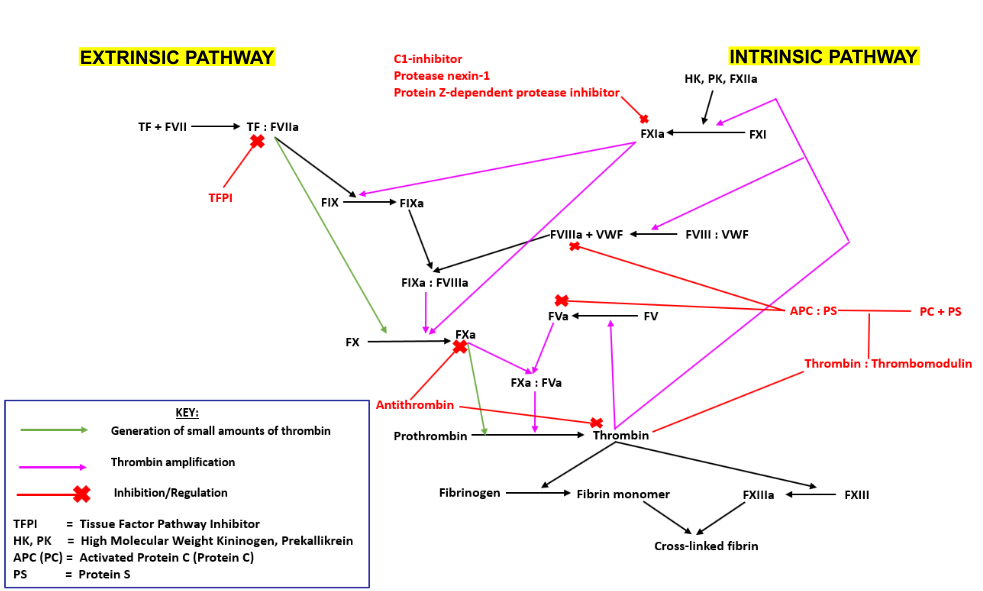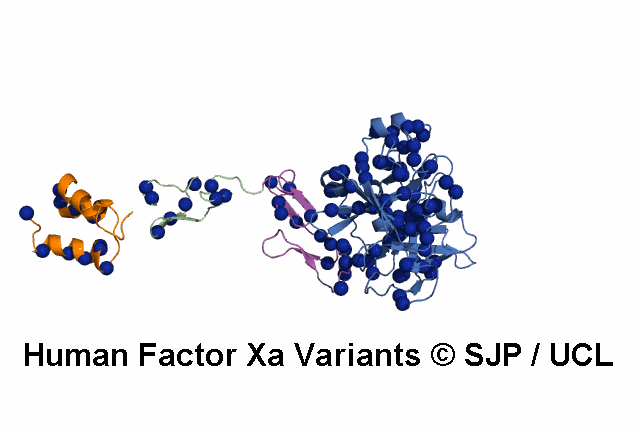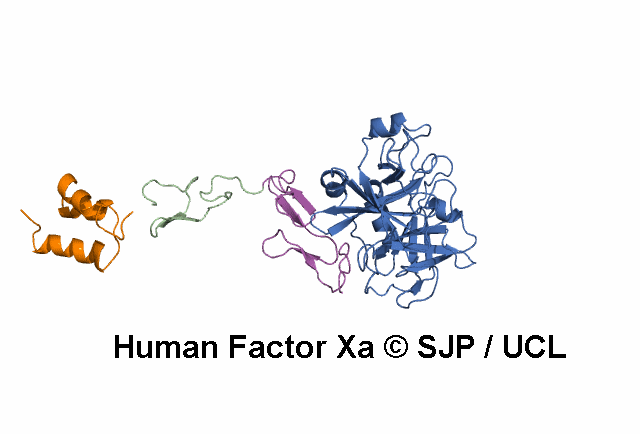FX is a plasma glycoprotein that plays a key role in the coagulation cascade. Specifically, activated FX (FXa) binds activated Factor V (FVa) forming the prothrombinase complex. Said complex cleaves prothrombin into thrombin, aiding formation of the platelet plug, critical in coagulation.
The coagulation cascade can be partitioned into the extrinsic and intrinsic pathways, with FX linking the two, driving thrombin production:
- The extrinsic pathway is initiated following vessel trauma, which results in the exposure of sub-endothelial tissue factor (TF) to the blood. TF forms a complex with activated Factor VII (FVIIa), which activates Factors IX (FIX) and X (FX). Activated FX converts prothrombin into thrombin.
- The intrinsic pathway is initiated upon contact of endothelial collagen with Factor XII (FXII), which itself is complexed with Prekallikrein (PK) and High Molecular Weight Kininogen (HK). Activated FXII catalyses the activation of FXI, which then interacts with the extrinsic pathway, activating FIX. FIXa complexes with activated FVIII (FVIIIa) forming the intrinsic-tenase complex, which subsequently cleaves and activates FX.
- The final common pathway involves the thrombin-mediated conversion of fibrinogen into fibrin, required for stable clot formation. Thrombin also activates Factor XIII (FXIII) which cross-links fibrin, enhancing its resistance to dispersion by high blood pressure.

FX is a vitamin K dependent (VKD) serine protease, consisting of a Gla domain, two epidermal growth factor (EGF) domains, an Activation Peptide (AP) and a Serine Protease (SP) domain. FX shares sequence and structural homology with other VKD coagulation proteins including Factor VII (FVII), Factor IX (FIX) and Protein C.
Note: The FX AP has yet to be crystallised owing to its flexibility and unstructured nature.

FX is synthesized in the liver and released into the blood in zymogenic form. Prior to release, the pre-pro leader peptide is post-translationally modified and subsequently cleaved. FX circulates in the blood as a two-chain glycoprotein prior to activation. The light chain consists of the Gla domain, EGF-1 and EGF-2, whereas the heavy chain is composed of the AP and the SP domains. The catalytic triad, His276 (His236), Asp322 (Asp282) and Ser419 (Ser379), resides in the SP domain.
FX can be activated either through the extrinsic pathway, involving the FVIIa/TF complex, or through the intrinsic pathway, involving the FVIIIa-FIXa intrinsic-tenase complex. Both processes involve proteolytic cleavage of the FX Arg234-Ile235 (Arg194-Ile195) bond, which releases the 52-amino acid AP from the N-terminus of the heavy chain. Cleavage results in a conformational change, enabling formation of the Ile235-Asp418 (Ile195-Asp378) salt bridge, exposing the active site and facilitating substrate binding. FX may undergo additional cleavage, removing a 17-amino acid peptide from the heavy chain C-terminus, forming FXa-β. However, the functional effect of this additional cleavage remains to be determined.
FXa alone has minimal affinity for the substrate prothrombin. However, once activated, FXa typically complexes with cofactor FVa, forming the prothrombinase complex, a complex with high prothrombin affinity. Prothrombin binds an exosite on the protease complex and is cleaved at two distinct sites, Arg320 and Arg271. Thrombin is subsequently released and facilitates platelet plug formation, preventing excess blood loss.
Variants within the F10 gene can cause FX deficiency, also known as Stuart-Prower Factor deficiency.
FX coagulant activity (FX:C) in normal human plasma ranges from 50-150 IU/dL. Severely FX deficient patients have FX:C levels of < 1 % of normal, moderately deficient individuals have FX:C levels of 1-5 % of normal and mildly deficient individuals possess FX:C levels of 6-10 % of normal.
Individuals with severe FX deficiency are typically homozygous or compound heterozygous for causative mutations, whereas individuals who are partially deficient are heterozygous, with one mutated allele.
Individuals with FX deficiency experience variable bleeding symptoms, the severity correlating with the level of protein activity. Individuals with lower FX:C will experience more severe symptoms than those with higher protein activity. Symptom onset can occur at any time, though severely affected individuals suffer from an earlier age.
- Mildly affected individuals experience minor symptoms such as easy bruising, nosebleeds, gum bleeding and hematuria (blood in urine). Such individuals are also prone to prolonged and excessive post-operative bleeding.
- Severely affected individuals suffer from more severe bleeds including hemarthrosis (bleeding into joints), intramuscular bleeds and hematomas. Additionally, such individuals are more susceptible to melena (blood in stool), bleeding in the gastrointestinal tract and intracranial hemorrhages.
- Females suffering from FX deficiency often experience menorrhagia (heavy or prolonged bleeding during menstruation). Such individuals are also at greater risk of pregnancy complications including miscarriage and post-partum hemorrhage (bleeding after pregnancy).
Current available therapy for FX deficiency consists of FX replacement and the use of antifibrinolytics/ fibrin glue.
FX Replacement: Coagadex, Prothrombin Complex Concentrates (PCC) and Fresh Frozen Plasma (FFP)
- Coagadex - Coagadex is used both as a preventative measure and as treatment for individuals with FX deficiency. Coagadex is a specific FX concentrate, composed of active FX from donor plasma, which acts to replace non-functional FX in deficient individuals. Coagadex helps promote coagulation and control bleeding. Coagadex was approved by the FDA in 2015.
- Prothrombin Complex Concentrate (PCC) and Fresh Frozen Plasma (FFP) – PCC and FFP are concentrates containing FX along with other coagulation factors such as Factors II, VII and IX. FFP is the fluid portion of whole blood and also contains additional plasma proteins. PCC and FFP are administered intravenously into deficient individuals to replace FX and promote coagulation.
Note: Given that PCC and FFP are not FX specific, problems such as thrombosis can arise due to accumulation of coagulation factors that the individual is not deficient in. In addition, whilst proving effective, the use of FFP and PCC is often contra-indicated and is thus precluded in significant numbers of individuals.
Antifibrinolytics/ Fibrin Glue: Used to treat individuals with minor forms of FX deficiency.
- Antifibrinolytics - Antifibrinolytics are drugs that work to prevent clot breakdown within the body, minimising the risk of excess bleeding. Examples of antifibrinolytics include tranexamic acid and aminocaproic acid.
- Fibrin Glue - Fibrin is a protein involved in cross-linking and stabilising clots within the body. Fibrin glue is used externally to facilitate clot formation and stabilisation. Fibrin glue is most commonly used post-operatively in FX deficient individuals to facilitate wound healing and minimise the risk of prolonged post-operative bleeding.



